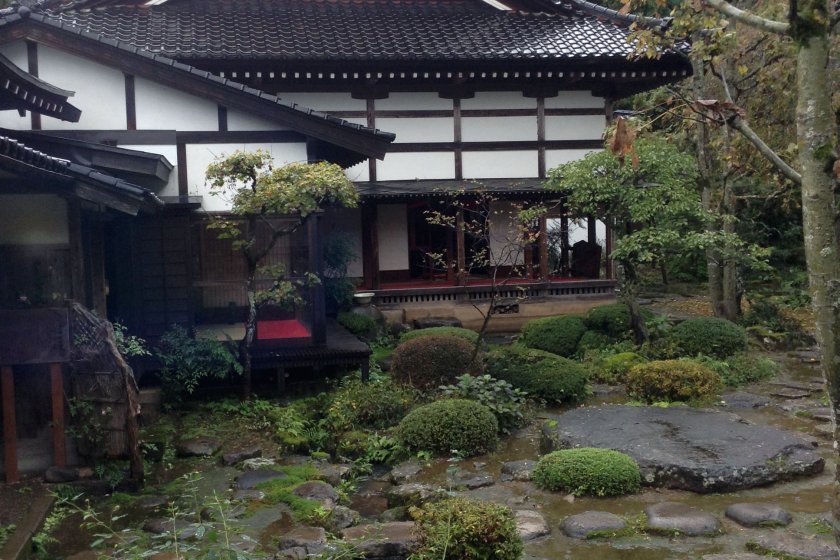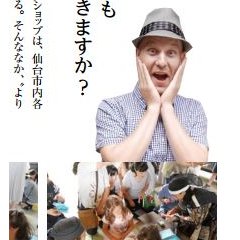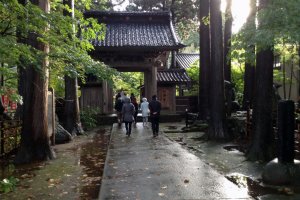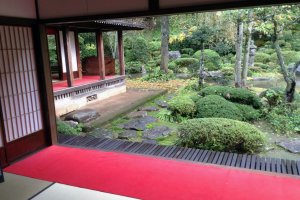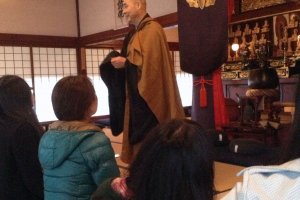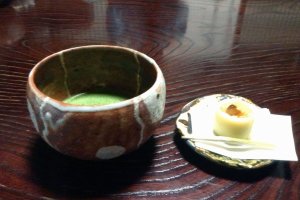At the base of the majestic three sacred peaks known as Dewa Sanzan in the town of Tsuruoka is a temple surrounded by a heavenly blanket of green. Gyokusenji Temple has been around since 1251 AD and has aged like fine wine. Not to be confused with the Gyokusenji Temple in Shizuoka which hosted the first US consulate in Japan, this Gyokusenji Temple is in Yamagata Prefecture.
According to legend, the Korean-born priest Ryonenhomyo built Gyokusenji Temple several centuries ago. Being the extraordinary disciple of the admired and respected Dogen, he shared the esthetic knowledge he picked up in China throughout Japan. While on this lengthy pilgrimage, he is also credited with setting the groundwork for Zen Buddhism through the construction of temples and other places where images of the deity Kannon were enshrined. A gap in historical records lingered for 200 years until the priest Nanei Kenshu of Kounji in Murakami Town, Niigata Prefecture was put in charge of the temple via request of the Lord of Shonai, Fujiwara. We can thank him for beginning the temple’s garden which was repaired in the 1600s by Tenyu, a head priest of Hagguro. Today the temple remains a place of history, religious studies, and inner beauty.
Gyokusenji Temple is a 15 minute walk from Ootorii bus station (about a 30 minute bus ride from Tsuroka station). Coming by car is also a great option because of the free onsite parking lot. A bridge from the modern day parking lot spans a stream that swells to dangerous speeds during the rainy season. But no matter when you arrive, once you pass through the main gate draped in the shadows of towering trees, you are in a safe, serene, and almost magical place. The front garden features various shrubbery, a pond where you might hear the splash of a jumping frog, and several small Buddhist statues or structures. Take off your shoes, pay a few hundred yen, and you are free to walk inside the buildings and wander the famous garden behind the temple (more on that later).
The temple is actually a series of interconnected rooms and hallways. Windows let in light and give views of the outside gardens. Traditional Japanese art, some related to Buddhism and others not, decorate every nook and cranny without feeling too crowded. Several pieces, such as a traditional tansu cabinet and a more than two century old wood carving, will have art fans giggling like Japanese school girls. A room down the hall on your left leads to the pray/mediation room. A few times a month, public Zen mediation classes are held here. Beginners are welcome and a priest will explain the proper etiquette. The explanation will be Japanese, but follow his gestures or the person next to you and you should be fine. If you make a mistake the priest “taps” you with a stick to correct (punish?) you. I succeeded in passable mediation technique so was not hit. However, it’s not painful…I am told.
Perhaps more famous then the temple itself might be the temple’s main garden. Located behind Gyokusenji Temple is a garden with centuries of antiquity and splendor. Don’t get too comfy lounging at the red carpeted veranda; you are welcomed and encouraged to take a closer look by following the stepping stones and paths around the carp-filled pond and into the small hills. The more adventurous visitors that travel deeper into the garden’s backwoods are greeted with solitary Buddhist statues, delicate flowers, wild bamboo, and a decaying cemetery.
Gyokusenji Temple is an excellent side trip either before or after your Dewa Sanzan experience. A temple to relax and contemplate in paired with a “temple of flowers,” so called for its year round blooming, give the history or nature lover something to be excited about. With such beauty, it is no wonder the garden was designated as a national cultural heritage site of scenic beauty in 1987.
